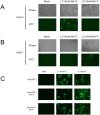Construction of a recombinant vaccine expressing Nipah virus glycoprotein using the replicative and highly attenuated vaccinia virus strain LC16m8
- PMID: 38100536
- PMCID: PMC10756534
- DOI: 10.1371/journal.pntd.0011851
Construction of a recombinant vaccine expressing Nipah virus glycoprotein using the replicative and highly attenuated vaccinia virus strain LC16m8
Abstract
Nipah virus (NiV) is a highly pathogenic zoonotic virus that causes severe encephalitis and respiratory diseases and has a high mortality rate in humans (>40%). Epidemiological studies on various fruit bat species, which are natural reservoirs of the virus, have shown that NiV is widely distributed throughout Southeast Asia. Therefore, there is an urgent need to develop effective NiV vaccines. In this study, we generated recombinant vaccinia viruses expressing the NiV glycoprotein (G) or fusion (F) protein using the LC16m8 strain, and examined their antigenicity and ability to induce immunity. Neutralizing antibodies against NiV were successfully induced in hamsters inoculated with LC16m8 expressing NiV G or F, and the antibody titers were higher than those induced by other vaccinia virus vectors previously reported to prevent lethal NiV infection. These findings indicate that the LC16m8-based vaccine format has superior features as a proliferative vaccine compared with other poxvirus-based vaccines. Moreover, the data collected over the course of antibody elevation during three rounds of vaccination in hamsters provide an important basis for the clinical use of vaccinia virus-based vaccines against NiV disease. Trial Registration: NCT05398796.
Copyright: © 2023 Watanabe et al. This is an open access article distributed under the terms of the Creative Commons Attribution License, which permits unrestricted use, distribution, and reproduction in any medium, provided the original author and source are credited.
Conflict of interest statement
The authors declare that they have no competing interests.
Figures




Similar articles
-
Single-dose live-attenuated Nipah virus vaccines confer complete protection by eliciting antibodies directed against surface glycoproteins.Vaccine. 2014 May 7;32(22):2637-44. doi: 10.1016/j.vaccine.2014.02.087. Epub 2014 Mar 12. Vaccine. 2014. PMID: 24631094 Free PMC article.
-
Recombinant vesicular stomatitis vaccine against Nipah virus has a favorable safety profile: Model for assessment of live vaccines with neurotropic potential.PLoS Pathog. 2022 Jun 27;18(6):e1010658. doi: 10.1371/journal.ppat.1010658. eCollection 2022 Jun. PLoS Pathog. 2022. PMID: 35759511 Free PMC article.
-
Single injection recombinant vesicular stomatitis virus vaccines protect ferrets against lethal Nipah virus disease.Virol J. 2013 Dec 13;10:353. doi: 10.1186/1743-422X-10-353. Virol J. 2013. PMID: 24330654 Free PMC article.
-
[Study of pathogenicity of Nipah virus and its vaccine development].Uirusu. 2014;64(1):105-12. doi: 10.2222/jsv.64.105. Uirusu. 2014. PMID: 25765986 Review. Japanese.
-
Nipah virus: epidemiology, pathology, immunobiology and advances in diagnosis, vaccine designing and control strategies - a comprehensive review.Vet Q. 2019 Dec;39(1):26-55. doi: 10.1080/01652176.2019.1580827. Vet Q. 2019. PMID: 31006350 Free PMC article. Review.
Cited by
-
A three-way interface of the Nipah virus phosphoprotein X-domain coordinates polymerase movement along the viral genome.J Virol. 2024 Oct 22;98(10):e0098624. doi: 10.1128/jvi.00986-24. Epub 2024 Sep 4. J Virol. 2024. PMID: 39230304 Free PMC article.
-
Immunogenicity and Neutralization of Recombinant Vaccine Candidates Expressing F and G Glycoproteins against Nipah Virus.Vaccines (Basel). 2024 Aug 31;12(9):999. doi: 10.3390/vaccines12090999. Vaccines (Basel). 2024. PMID: 39340029 Free PMC article.
-
Emerging and reemerging infectious diseases: global trends and new strategies for their prevention and control.Signal Transduct Target Ther. 2024 Sep 11;9(1):223. doi: 10.1038/s41392-024-01917-x. Signal Transduct Target Ther. 2024. PMID: 39256346 Free PMC article. Review.
-
Comparison of the induction of neutralizing antibodies against Bas congo virus using several vaccine modalities.Sci Rep. 2025 May 10;15(1):16285. doi: 10.1038/s41598-025-01213-w. Sci Rep. 2025. PMID: 40348847 Free PMC article.
-
Recent Advances in Immunological Landscape and Immunotherapeutic Agent of Nipah Virus Infection.Cell Biochem Biophys. 2024 Dec;82(4):3053-3069. doi: 10.1007/s12013-024-01424-4. Epub 2024 Jul 25. Cell Biochem Biophys. 2024. PMID: 39052192 Review.
References
MeSH terms
Substances
Associated data
LinkOut - more resources
Full Text Sources
Medical

